
Lyngbya is a genus of cyanobacteria, unicellular autotrophs that form the basis of the oceanic food chain.

Anabaena is a genus of filamentous cyanobacteria that exist as plankton. They are known for nitrogen-fixing abilities, and they form symbiotic relationships with certain plants, such as the mosquito fern. They are one of four genera of cyanobacteria that produce neurotoxins, which are harmful to local wildlife, as well as farm animals and pets. Production of these neurotoxins is assumed to be an input into its symbiotic relationships, protecting the plant from grazing pressure.

Ulothrix is a genus of green algae in the family Ulotrichaceae.

Halimeda is a genus of green macroalgae. The algal body (thallus) is composed of calcified green segments. Calcium carbonate is deposited in its tissues, making it inedible to most herbivores. However one species, Halimeda tuna, was described as pleasant to eat with oil, vinegar, and salt.

Navicula is a genus of boat-shaped diatom algae, comprising over 1,200 species. Navicula is Latin for "small ship", and also a term in English for a boat-shaped incense-holder.
Schmitzia hiscockiana is a small, rare, red seaweed or marine alga of the phylum Rhodophyta or red algae. It was discovered and named in 1985.
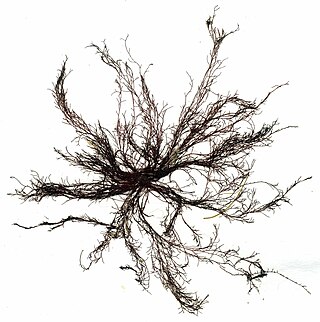
Polysiphonia is a genus of filamentous red algae with about 19 species on the coasts of the British Isles and about 200 species worldwide, including Crete in Greece, Antarctica and Greenland. Its members are known by a number of common names. It is in the order Ceramiales and family Rhodomelaceae.

Dictyosphaeriaceae is a family of green algae. As of February 2022, AlgaeBase places two genera in the family:

Botryococcus is a genus of green algae. The cells form an irregularly shaped aggregate. Thin filaments connect the cells. The cell body is ovoid, 6 to 10 μm long, and 3 to 6 μm wide. Fossils of the genus are known since Precambrian times, and form the single largest biological contributor to crude oil, and are a major component of oil shales.
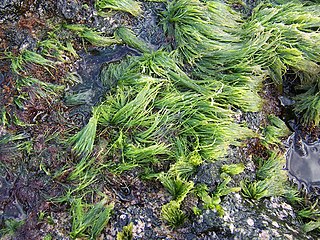
Chaetomorpha is a genus of green algae in the family Cladophoraceae. Members of this genus may be referred to by the common name sea emerald.

Draparnaldia is a genus of freshwater green algae in the family Chaetophoraceae. Draparnaldia are uniseriate; each filament is composed of a chain of cells arranged in one row. Chloroplasts appear as a band within the center of each cell. The length of the main axis cells are generally the same, regardless of whether or not they bear branches. These side branches are divided extensively into terminal hairs. The entire plant is enveloped in loose, slippery mucilage. Draparnaldia is a cosmopolitan genus with wide distribution and it is usually found in cold aerated waters. They are either attached to sand or grow epiphytically on other aquatic plants. Draparnaldia can be seen growing in clear streams trailing on stones and boulders. Herman S. Forest of The Southern Appalachian Botanical Club has stated that while not common, it is present frequently enough to be recorded in almost all local flora lists of green algae that have been compiled. A multitude of species are present in Lake Baikal, Siberia and have been described by Meyer and Jasnitzky. A species of the genus had been placed and described in the Linnean Herbarium as Conferva Mutabilis Roth in 1797. Nowadays Conferva is no longer used and the species is described as Draparnaldia mutabilis (Roth) Bory. Bory is added in honour of the researcher of the same name, based on whose description the genus was separated from similar appearing forms. Bory is accredited with the establishment of the genus.

Desmidium is a genus of green algae, specifically of the Desmidiaceae.

The Klebsormidiaceae are a family containing five genera of charophyte green alga forming multicellular, non-branching filaments. The genus Chlorokybus was previously included as well, but this problematic and poorly known genus is now placed in a separate class Chlorokybophyceae.

Phalansterium is a genus of single-celled flagellated organisms comprising several species, which form colonies. Phalansterium produces tetraspores.
Leucocryptos is a genus of single-celled eukaryotes comprising one to two species.
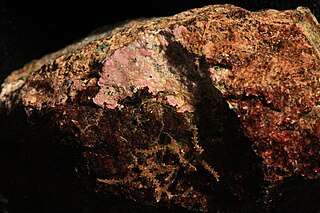
Hildenbrandia is a genus of thalloid red alga comprising about 26 species. The slow-growing, non-mineralized thalli take a crustose form. Hildenbrandia reproduces by means of conceptacles and produces tetraspores.
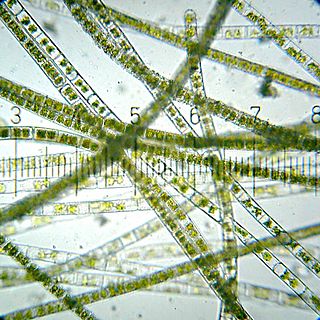
Zygnema is a genus of freshwater filamentous thalloid alga comprising about 100 species. A terrestrial species, Z. terrestre, is known from India. Zygnema grows as a free-floating mass of filaments, although young plants may be found anchored to streambeds with a holdfast. The filaments form a yellow-green to bright green colored tangled mat, and are composed of elongate barrel-shaped cells, each with two star-shaped (stellate) chloroplasts arrayed along the axis of the cell.
Synarthrophyton is a genus of thalloid red algae comprising eight species. The monomerous, crustose thalli are composed of a single system of filaments which grow close to the underlying surface. Synarthrophyton reproduces by means of flask-shaped multiporate conceptacles; it produces tetraspores and dispores. Mucus plugs the opening of young conceptacles, which open as they mature.

Claudea is a marine red alga genus.
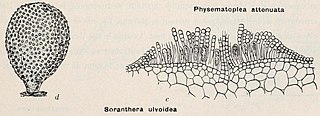
Soranthera ulvoidea, sometimes called the studded sea balloon, is a species of brown algae in the family Chordariaceae. It is the only species in the monotypic genus Soranthera. The generic name Soranthera is from the Greek soros (heap) and antheros (blooming). The specific epithet ulvoidea refers to certain resemblances the algae has with Ulva. The name in Japanese is 千島袋のり / ちしまふろくのり literally meaning "Kuril Islands bag nori".
















